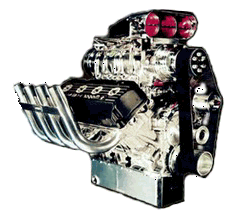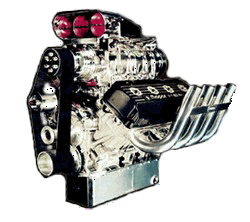


Roots Blower History

Our novelty casting of the 6-71 GMC blower is based on a mechanical “air mover” design with an interesting history. The Roots device is a positive displacement pump, used as an air pump or fluid pump. It moves air, but does not compress. The basic design was patented in 1860 by Philander Higley and Francis Marion Roots (hence the name) of Connersville, Indiana, as an air pump for mines, grain elevators, blast furnaces, and other industrial applications. As an air pump, it pulls air by trapping it with meshing lobes against the outer side of the blower case and pushes air from the intake side to the exhaust side. In an engine application, when pumped into a confined space such as an intake manifold, positive pressure is developed, along with an increase in temperature of the pressurized air (not a good thing). An intercooler can be used to help cool the charged air.
Roots blowers are typically used where the volume of air moved is large compared to the pressure differential. They also can be run in reverse to measure flow of gases or liquids, such as a gas meter. Since there must be operational clearance between the rotors, a single Roots blower can only pump across a limited pressure differential. Use of Teflon wiping strips in race car blowers increases efficiency, but only so far. If a Roots blower is operated out of normal parameters, the heat generated can expand the rotors to the point that they jam, with obvious results. Since Roots blowers can pump large volumes, but only at moderate compression, they are sometimes used in blower stages, frequently with intercoolers used between to cool the gas (air).
Use of Roots type blowers on internal combustion engines started around 1900, including patenting by Gottlieb Daimler of a Roots supercharged engine design, making the Roots design the oldest of supercharger designs currently used. Also in Germany, Mercedes worked at making the Gottlieb Roots style blower work, and by 1921 released a production vehicle with a blower. They made several successful Roots blown models over the next several years.
In the mid Thirties, General Motors wanted to come up with a compact and powerful diesel design, as most of the diesel engines of the time that produced much power were large and cumbersome. In 1939, they finalized development of a 2 stroke diesel engine with six cylinders of 71 cubic inches each (totaling 426 cubic inches, coincidentally). It was called a “6-71”. These 2 strokes did not have a separate intake stroke, so a forced induction system was required, and the Roots blower design was used for the purpose, resulting in the GMC 6-71 blower. In the application, the blowers did not provide significant air compression, just air movement, and the engines were considered naturally aspirated. Turbochargers are added when boost is required. There are numerous GMC engine models with a different number of cylinders and corresponding blower case length. Some of the models were built by joining two existing models together, i.e. two 6V-71 joined to make a 12V-71.
GMC 71 Series Diesel Models
| Model |
Displacement Liters |
Displacement Cubic Inches |
Engine Type | Horsepower |
| 1-71 | 1.2L | 71ci | 1 Cyl. | 10 |
| 2-71 | 2.3L | 142ci | I-2 | 68 |
| 3-71 | 3.5L | 213ci | I-3 | 113 |
| 4-71 | 4.7L | 284ci | I-4 | 121 |
| 6-71 | 7.0L | 426ci | I-6 | 190 |
| 6V-71 | 7.0L | 426ci | V-6 | 210 |
| 8V-71 | 9.3L | 568ci | V-8 | 318 |
| 12V-71 | 14.0L | 852ci | V-12 | 450 |
| 16V-71 | 18.6L | 1136ci | V-16 | 480 |
| 24V-71 | 27.9L | 1704ci | V-24 | 1800 |
The earlier Roots blowers used on hotrods and race cars were usually taken off a GMC diesel and modified for such use. The blowers used currently in the top blown classes of racing are derivatives of these units, usually using the same nomenclature like 10-71, 12-71, 14-71, as different blower manufacturers added case and rotor length as air flow requirements increased.
There are also 53 and 92 series GMC engines with blowers, but for some reason they were not adapted for performance use.
Barney Navarro is usually credited with the first installation of a GMC blower on a race car/hot rod. This was a 3-71 unit brought to him by Kong Jackson (Roto-Faze ignitions), taken off a WWII landing craft. Barney was making his own patterns and having castings done for flat head Ford intake manifolds and heads at that time, so he modified an intake pattern to fit the blower, and had one cast. He bored the blower case a little to increase rotor clearance for the heat build up with the boost he was going to run. He used a V belt drive and four Stromberg carbs running alcohol through the blower to a destroked flathead V-8 in his roadster, which ran 147 mph. Barney ran the car at the dry lakes and dirt circle tracks, having to solve drive belt issues rather than mechanical issues with the blower. He also ran the roadster at the drags in Santa Ana in 1950, one of the first to run a blower in a drag racing venue. Tom Beatty, who worked with Barney, built a belly tank lakester, using a Navarro blower setup, and set an open wheel top speed record with it. Beatty made manifolds and drive kits for the GMC blowers and expanded their use considerably.
An interesting side-note about the “Mini-Blower” casting and Barney Navarro. When Larry (who came up with the Mini Blower idea, and built the patterns) was a kid, he went with his dad all the time to the local auto parts store in Eagle Rock, California, where they lived at the time. Every so often they would see “Barney” at the parts store or on the street, and his dad would talk for a while. Larry never knew Barney’s last name, as he was just his dad’s friend “Barney”, who had a shop in Eagle Rock. Later, when Larry was in his twenties, he had a friend Frank, in Glendale, California, who worked on cars as well. Every once in a while, when over at his friend’s house, the neighbor lady’s son would show up to visit, and pop over to see what was going on, like stuffing a Racer Walsh cam into a Pinto. The visitor (Barney, again) was just the “guy with the interesting twin turbo Corvair, who built some sort of medical equipment”. As well as building cars and heads and manifolds, etc., Barney developed a heart and lung machine used by the Kaiser Hospital in Hollywood for 13 years. It wasn’t until years later when Hot Rod magazine did an article on Barney Navarro that this all came together. Larry saw the article, with some early pictures of Barney, and thought he was familiar. He showed the article to his dad, who said “Hey! That’s Barney!”. Later, in a phone conversation with Frank, the friend from Glendale, Larry mentioned the article and showing it to his dad, and that it was Barney Navarro, he used to see as a kid. Frank said “what do you mean used to see him when you were a kid? He was the guy who used to see what we were up to when he came by to visit his mom next door to my parent's house”. Small world. Ask about Larry’s dad and Kent Enderle (Enderle Fuel Injection) for another story. Back to blowers.
While there may be small leakage at low rpm, since the Roots design is positive displacement, it can’t flow backward, as a centrifugal blower can, keeping low RPM efficiency near its high RPM efficiency. This results in decent low RPM boost, and therefore, good low and midrange power. There is no lag. As Roots blowers are a simple design, with self-contained lubrication, they are very reliable and reasonably priced.
Eaton Corp. began a development program in 1984 to bring an updated Roots type blower to the OEM level for power enhancement on luxury and performance cars. The new Eaton TVS units use high helix rotors with three or four lobe rotors, and an axial air intake at the front or rear. These more efficient units were first used on the 1989 Thunderbird Super Coupe, and numerous variants on other OEMS since, including the LS9 Corvette, which uses a thin heat exchanger (intercooler) between the blower and heads. The Eaton blower for the new Mustang GT500 has four lobe rotors.
So, 100-plus years later, the Roots style blower is still in use on race cars and at the OEM level, and still inspires awe when seen sitting on top of an engine. There are centrifugal blowers, screw-type blowers, and turbochargers, which all have their place in history, past and present, but there is nothing like the whine of a Roots.


